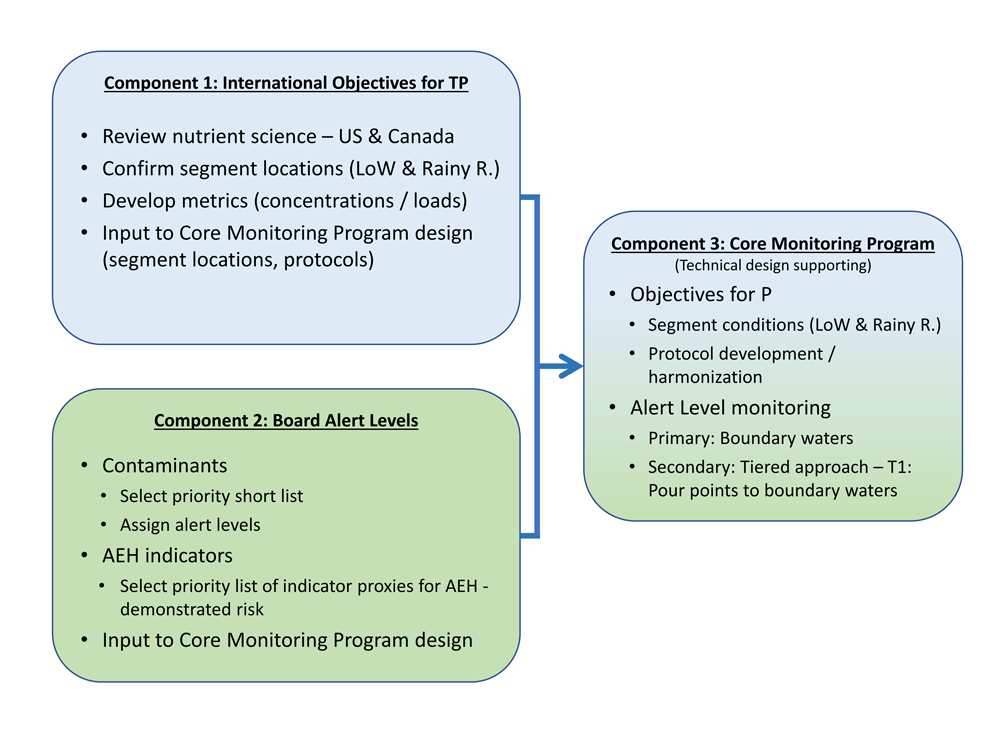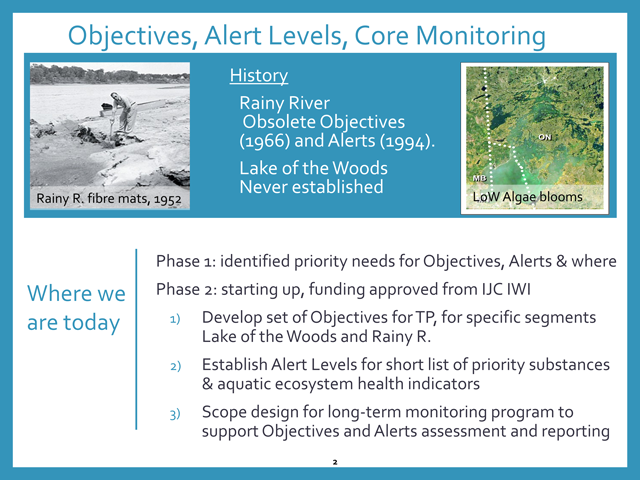 IJC Watershed Board Project schematic: Objectives, Alert Levels, and Monitoring program for Rainy-Lake of the Woods watershedThe Lake of the Woods Water Sustainability Foundation plays an essential role in coordinating the network of resource management agencies, government partners, and civil society contributors to watershed science and governance. This year, our coordination has been instrumental in driving forward the second phase of a project to develop recommendations for international water quality Objectives and Alert Levels for the Rainy-Lake of the Woods Watershed. The International Joint Commission holds oversight responsibilities for water quality in our watershed, so this project will be administered by the IJC watershed board’s Aquatic Ecosystem Health (AEH) Committee, which is co-chaired by the Foundation Executive Director, Todd Sellers.
IJC Watershed Board Project schematic: Objectives, Alert Levels, and Monitoring program for Rainy-Lake of the Woods watershedThe Lake of the Woods Water Sustainability Foundation plays an essential role in coordinating the network of resource management agencies, government partners, and civil society contributors to watershed science and governance. This year, our coordination has been instrumental in driving forward the second phase of a project to develop recommendations for international water quality Objectives and Alert Levels for the Rainy-Lake of the Woods Watershed. The International Joint Commission holds oversight responsibilities for water quality in our watershed, so this project will be administered by the IJC watershed board’s Aquatic Ecosystem Health (AEH) Committee, which is co-chaired by the Foundation Executive Director, Todd Sellers. IJC watershed board project to recommend international water quality objectives, alert triggers, and monitoring program designObjectives are international standards agreed to by Canadian and U.S. governments for boundary waters. Alert Levels are IJC watershed board-adopted trigger thresholds for advising the IJC and governments of issues of potential concern, where there are no international Objectives established.
IJC watershed board project to recommend international water quality objectives, alert triggers, and monitoring program designObjectives are international standards agreed to by Canadian and U.S. governments for boundary waters. Alert Levels are IJC watershed board-adopted trigger thresholds for advising the IJC and governments of issues of potential concern, where there are no international Objectives established.
Contemporary international water quality objectives for the boundary waters of Lake of the Woods and the Rainy River and Alert Levels for the broader watershed have not been established. Phase 1 of the Objectives and Alert Levels project identified that that phosphorus, a nutrient that feeds excessive algae blooms on Lake of the Woods, was the only issue significant enough to warrant internationally agreed-upon Objectives. Phase 1 recommended developing a set of total phosphorus Objectives for various segments of the Lake of the Woods and the Rainy River, whereas other contaminant or aquatic ecosystem health issues could be addressed by Alert Levels.
Phase 2 of the project is now moving forward, having received funding approval from the IJC International Watershed Initiative Program. For this project, water resource experts will work to develop a suite of specific metrics (i.e., concentrations, loads) to be recommended for international Objectives for segments of Lake of the Woods and the Rainy River. These partners will also select and establish Alert Levels for a short list of contaminant substances and aquatic ecosystem health indicators (e.g., invasive species) based on demonstrated risk. Finally, the project experts will provide a technical scoping to recommend elements of a core (a.k.a. long-term) monitoring program to support these Objectives and Alert Levels for exceedance reporting, progress assessment, and adaptive management in the future.
The Foundation will continue to support the Phase 2 project team’s work while helping to communicate its recommendations to the public. Ultimately, the goal of all who contribute to this project is to see Objectives and Alerts put in place that will help us achieve and sustain better water quality throughout the watershed.
Second Phase Underway for IJC Watershed Board Review of Water Quality Objectives
- Details
